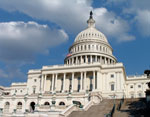Congress Back from Recess to Deal with FY16 Appropriations
Sep 08, 2015
 When Congress returns from recess on September 8, there will be just ten legislative days before the start of the 2016 fiscal year on October 1. The Transportation, Housing, and Urban Development, and Related Agencies (THUD) Subcommittees’ FY16 bills, passed by the full House (see Memo, 6/15) and the Senate Committee on Appropriations (see Memo, 6/29), are expected to remain stalled until either the sequester spending caps are lifted or one or more continuing resolutions (CRs) take their place. The White House has made clear that President Barack Obama will not sign FY16 spending bills that do not lift sequester spending caps.
When Congress returns from recess on September 8, there will be just ten legislative days before the start of the 2016 fiscal year on October 1. The Transportation, Housing, and Urban Development, and Related Agencies (THUD) Subcommittees’ FY16 bills, passed by the full House (see Memo, 6/15) and the Senate Committee on Appropriations (see Memo, 6/29), are expected to remain stalled until either the sequester spending caps are lifted or one or more continuing resolutions (CRs) take their place. The White House has made clear that President Barack Obama will not sign FY16 spending bills that do not lift sequester spending caps.
In the short term, Congress is likely to pass a CR lasting anywhere from four weeks to three months. A CR allows discretionary programs to continue, but at FY15 funding levels. Before a short-term CR expires, Congress must decide whether to lift the sequester spending caps for FY16 or vote for a longer, possibly year-long CR. With the White House insisting that FY16 spending bills maintaining sequester spending caps will not be signed by the President, if Congress cannot reach agreement on whether and how to lift the caps and opts instead to pass a year-long CR, the White House and Congress will be in yet another stand-off. However, Republican leaders have stated they want to avoid another government shutdown.
HUD’s largest programs can weather a CR through December. HUD’s major rental assistance programs - Public Housing, Project-Based Section Rental Assistance (PBRA), and Housing Choice Vouchers - are funded on a calendar year basis. They have sufficient resources to last until the end of the year from FY15 appropriations. However, renewal costs for vouchers and PBRA contracts require increases next year simply to serve the same number of households currently served and receipts from the Federal Housing Administration (FHA) are down compared to FY15. Level funding into 2016 would result in a shortfall of about $3 billion for HUD programs in FY16. A year-long CR that funds federal programs would be below sequester cap levels and result in funding levels for housing and community development programs in FY16 of as much as 4% below FY15 levels.
The negative impact of the sequester cap levels is evident in both the House and Senate THUD FY16 bills. The House bill raids 100% of National Housing Trust Fund resources in 2016 and directs them to the HOME Investment Partnerships Program (HOME), which the House bill cuts from $900 million in FY15 to $767 million. (Funding for the HOME program has already been reduced dramatically since FY10, when it received $1.8 billion.) The House bill does not fully fund the renewal of either current vouchers or PBRA contracts. The House bill would cut public housing capital funds from $1.875 billion in FY15 to $1.681 billion in FY16 and would reduce funding for HUD’s Office of Healthy Homes and Lead Hazard Control from $110 million to $75 million in FY16.
The Senate Committee on Appropriations’ THUD funding bill would effectively eliminate the HOME program, bringing funding from $900 million in FY15 to $66 million in FY16. By eliminating this critical housing program, the Senate bill is able to provide sufficient resources to renew existing PBRA contracts. But the bill also makes deep cuts to public housing capital subsidies and fails to renew about 50,000 Housing Choice Vouchers currently in use.
The Senate bill also includes a large expansion of the Moving to Work (MTW) demonstration, increasing the number of public housing agencies (PHAs) in the demonstration by 300 from the current 39. The Senate expansion comes with minor reforms, includes no requirements for evaluation of the demonstration, and enacts no protections for current or future residents. NLIHC’s position is that any expansion of MTW must includes rigorous evaluations and additional resident protections.
If Congress does raise sequestration spending caps, as many observers anticipate, it cannot be at the expense of other programs that assist low income households, such as Medicaid or Supplemental Nutrition Assistance Program (SNAP, formerly food stamps). Also, any acceptable sequester relief must have parity, meaning any spending caps imposed on nondefense discretionary programs, like housing, must be on par with those sustained by defense programs.